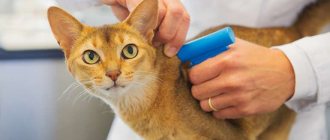Microchipping cats is a modern way of identifying an animal. The chip is implanted under the skin, so the cat will not lose it, as often happens with name collars and tags. In addition, the chip contains important information about the owner and animal - name, vaccinations, diseases.
- 2 Microchip structure
- 3 How is chipping carried out?
3.1 Video about the pros and cons of microchipping, opinions of owners, veterinarians and lawyers
Why is microchipping important?
For two decades now, pet owners have preferred to know where their pet is using chips. For European countries, the procedure is legalized and mandatory.
It takes less than a quarter of an hour and is completely painless, not to mention the completely symbolic price of microchipping cats.
Thanks to this modern method, you can always track the whereabouts of your pet. Initially, special stamp seals were used for this, which left an imprint on the skin with letters and a specific license plate. Another way was a tattoo similar to a human one.
These are marked:
- They were painful for the animal;
- Done in the abdominal area or on the thigh;
- Subject to deformation over time, becoming unrecognizable;
- They fade, complicating the identification procedure;
- It is necessary to periodically update, causing new suffering.
These are the reasons why there has been a widespread abandonment of such methods. The microchip is left as the only possible method for identification.
Where is the data stored on the chip?
After inserting the device under the animal’s skin, the clinic administrator first enters it into the clinic’s local database. And then it exports the data to the database of the country where the procedure was performed. Don’t forget to ask the operator which database he entered your cat into.
The largest databases of microchipped animals:
- https://new.animal-id.ru/ is the largest Russian one, it’s better to start with it;
- https://www.europetnet.com/ - the largest European base;
- https://animal-id.net/ is the largest Ukrainian database. After registration, information about the pet is available in the www.europetnet.com database, since both are partners.
Separate animal bases can be created in regions. In any case, after the operator has entered your cat into the database, you can add or correct information about it yourself. Of course, in addition to the chip number, the type of animal and its breed. In order to supplement information about your pet, you must register on the database website, confirm ownership of the animal and make the necessary changes. It is worth noting that in most Russian databases you can enter data about the animal and the installed chip yourself.
Benefits of chipping
What are the advantages of this procedure:
- Its duration, along with the preparatory stage, takes no more than fifteen minutes;
- The actual insertion of the chip takes one minute;
- The animal does not feel any pain;
- A special shell, biologically compatible with the body, will never fester, and is also not capable of causing allergic reactions;
- It is convenient to move with it, which is always necessary when participating in exhibition events;
- Information updating is provided remotely.
Inserting the chip is accompanied by a slight inconvenience, similar to performing a regular injection.
Caution won't hurt
Although the operation is simple, it should not be performed on sick or weakened animals. Although the capsule is coated with a material that is not rejected by the cat's body, some bacteria still enter. With low immunity, there is a high risk of local inflammation.
If the pet was purchased as an adult, before microchipping, be sure to check whether the animal has an already installed identifier. Of course, a second chip will not harm a cat or dog, since it is safe for the body, but there will be a fair amount of confusion.
In the absence of a scanner, the chip is inactive and completely harmless to the animal and owner
After administering the capsule, it is necessary to ensure that the animal does not scratch the injection site and monitor the general condition of the wound. In case of redness within a week after injection, it is best to contact your veterinarian again. In rare cases, an animal develops intolerance to the biomaterial from which the capsule is made; inflammation or suppuration is a reason to immediately consult a doctor.
Stages of implantation
To have an idea of what microchipping a cat means, you must first familiarize yourself with the sequence of this procedure:
- The cat must be fixed at the preparatory stage, then the capsule is opened;
- The places where the chip is inserted are processed;
- The actual introduction is carried out.
It is common for cats to be more afraid of both unfamiliar surroundings and people. That is why the veterinarian’s visit should not be accompanied by frightening factors for the animal - forcible removal from a secluded corner and other hectic preparations. Calling a doctor to your home is a more painless way for your pet’s psyche.
In addition, it is better not to rush, but to let the cat get used to it by playing with it for a short time and treating it to something tasty. Being constantly nearby is a prerequisite, and it is advisable to remain absolutely calm.
Reasons to microchip a cat
Not all cat owners understand why they should spend money on the microchipping procedure, but sometimes a chip is simply necessary - for example, if you are going to travel abroad with your cat.
Why else do cats get chipped?
- you can easily determine who owns the animal;
- identified purebred animals will be very difficult to steal;
- if a cat goes missing, the chip will help you find it;
- It is convenient for veterinarians to track the entire history of visits to a particular pet - for treatment, vaccinations, etc.
The law recommends that owners of purebred cats who attend exhibitions and participate in breeding have them microchipped.
What's so special about chipping?
The chip contains all the necessary information that concerns the owner and the pet itself. It is quite easy to read when you hold the scanner to the surface of the skin. Cashiers in a store do the same thing, for example.
The code includes a fifteen-digit combination:
- Country code of registration and residence – the first three digits;
- The four subsequent characters will tell you about the chip manufacturer;
- The eighth character contains the pet's name;
- The ninth can tell about coloring;
- Information about the breed is contained in the tenth character;
- Number eleven helps you learn about vaccinations;
- The owner's name and surname are placed under the twelfth license plate;
- Contact information is on the thirteenth position;
- The fourteenth sign determines the actual place where the owner lives;
- Information about the pedigree and special signs of the cat are in the fifteenth character.
Thanks to chipping, the information is reliable, complete and specific.
There are currently two types of microchips:
- For simpler ones, with a mark in the form of the letter R, it is typical to use information entered once;
- Where there is a designation in the form RF, the type is more modern, which allows for future data rewriting.
They involve annual updating of information regarding vaccination, the owner’s contact phone number or all his data, and various emergency situations.
How does the procedure work?
Only healthy animals with all the necessary vaccinations and strong immunity can be microchipped. Before the procedure, it is important to check the pet’s health status and, if necessary, first treat it and undergo a recovery period of rehabilitation. There is an age limit for microchipping - the cat must be five weeks old. Typically, cats are microchipped at the age of two months, when the animal has grown and become stronger.
The procedure itself is similar to vaccination - it is quick and painless, no anesthesia is required. After checking the functionality of the chip, the veterinarian disinfects the withers and gives an injection with a disposable syringe, inserting the chip under the skin. The withers are considered the optimal place, because constantly licking cats will not get there. Afterwards, the veterinarian makes a corresponding note in the veterinary passport.
It is highly desirable that the microchipping procedure be performed by an experienced veterinarian - he will ensure complete sterility and guarantee that the animal will not be hurt. For an experienced veterinarian it will not be difficult to microchip a long-haired cat - he will do everything as needed, and the capsule with the chip will not get lost in the fur.
You will need to contact the veterinarian in a month to check the functionality of the device. Initial activation and registration of the device in the system will take up to 10 days. The cat owner or veterinarian can enter data into the system. The information goes into both the veterinary clinic database and the central server.
What the reviews say
The main positive feature of all reviews about microchipping a cat is the ability to quickly detect the location of the animal. It’s also easy to find and notify the owner about it.
- Quite often, cats become frightened by sounds and noise on the street, running away quite long distances from their permanent habitat.
- Therefore, if it accidentally slips out of a window or doorway, it may find itself in an unfamiliar environment.
- Ordinary passers-by, seeing a well-groomed pet, can in this case provide all possible assistance.
- You can simply take the cat to the nearest veterinary clinic.
- There is always a device here that allows you to scan the chip.
- Staff, having received the necessary information regarding both the cat and its direct owner.
- Then all that remains is to contact him in order to transfer the animal from hand to hand.
On special websites you can always find information regarding the possibility of microchipping at home.
In addition, there is all the necessary information on choosing the most suitable model for your pet and when to call a veterinarian at home.
Microchip structure
The microchip is small in size and coated with biocompatible material
A chip is a microcircuit built into a capsule made of special sterile biocompatible glass, which will not allow it to “walk” throughout the animal’s body. The chip has a unique 15-digit code that is entered into the global database. The capsule size is very small - a little larger than a grain of rice.
A sticker with a unique 15-digit number appears in the animal’s passport, pedigree and veterinarian’s documents.
The microchip does not create any radiation, it is absolutely safe for animals and their owners and is activated only when it enters the electromagnetic field of the scanner.
Photos of cat microchipping
Detailed description of the process
Would you like to have your pet microchipped, but are you afraid that he will be hurt during the manipulation, and then all his life the poor thing will feel discomfort from the presence of a foreign body in the body? Completely in vain! This procedure is completely safe and virtually painless, and after it microchipped cats do not experience any discomfort.
What does the chip look like? Photo
The identification chip implanted under the skin of an animal is very small in size. The capsule in which it is placed is about one centimeter in length and no more than two millimeters in width. This is the size of one oblong grain of rice. It is made of ceramics or high-tech glass. The presence of these materials in the body of any living creature, be it an animal or a human, is absolutely safe, since they are hypoallergenic and do not cause a negative reaction from the immune system. The body simply does not “notice” them.











